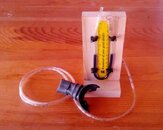- Messages
- 17,699
- Reaction score
- 9,970
- Location
- Somewhere between here and there
- # of dives
- 2500 - 4999
It's funny the tools we think we need. Up until recently I've always used an inline adjuster to set lever but it's an Apeks tool with only slotted end. I rebuilt some recently purchased HOGs last weekend and of course couldn't use the adjuster so did it the "long" way. I actually found it easier to make small finer adjustments using a hex key and because the hose only needs to be finger tight connecting and disconnecting was very easy. Whole process maybe 5 mins. I've always use a mag gauge too, think I'm going to try the sink method. I'm relatively new to the self servicing game so it's interesting to read what the more experienced folk do and what you can make do with. Cheers.




